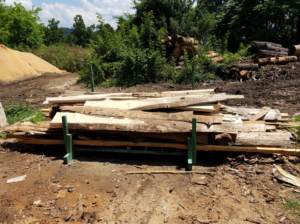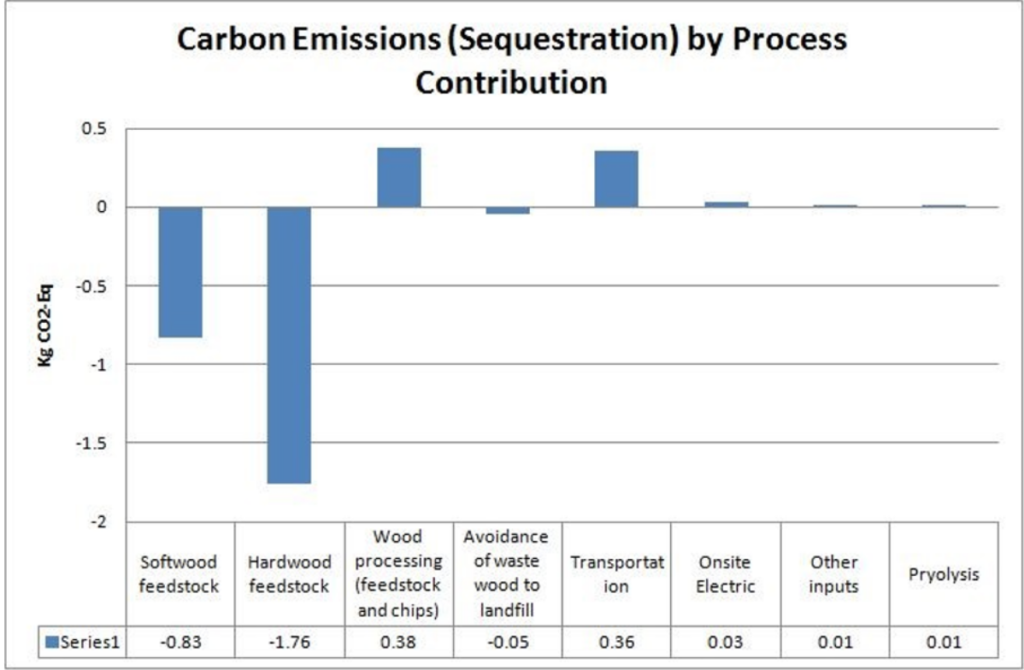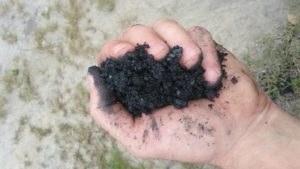By Dan Hettinger, Biochar Facility Manager
The increase in annual global carbon emissions has stalled in recent years despite strong global economic growth. In effect, economic growth is no longer coupled with increased carbon emissions. In 2015, most of the world agreed that we can limit climate change to a rise of 2 degrees Celsius. This is all great news for everyone, especially those who are most impacted by climate change. However, some say that the 2C goal is unattainable without the use of technologies that actively remove carbon from the atmosphere.
Biochar production has been recognized as one of these carbon negative technologies.
Biochar is biomass that has been carbonized through a process called pyrolysis, rendering its labile carbon in a more stable form. When added to soils, this stable, recalcitrant carbon is resistant to decay, and has the potential to sequester carbon much longer, potentially for thousands of years. For those that have followed our work here at Living Web Farms, you know that with the help of our friends at Chargow, LLC we’ve talked about this before.
We all know plants take in carbon dioxide in a process called photosynthesis, and this carbon is released when these plants are burned. What might not be as apparent is how most of the stored carbon in dead material is slowly released back into the atmosphere through eventual decay. This is where pyrolysis comes in. Instead of being piled up and burned, or left in the field to rot, waste plant material is diverted into an oxygen limited chamber, called a retort. Here, through the application of heat, complex molecules present in the biomass are broken down either into gasses that can be easily condensed as wood vinegar, tar and bio-oil, or non-condensable gasses that be stored or burned for heat or electricity. Leftover from this process is a high quality lump charcoal that we call biochar when it’s incorporated into soils.
For years now we’ve been making biochar in batches with wood waste from local mills. We use a 14’ diesel flatbed for pickup and local shipments, an LP forklift, our share of gasoline small engines and a fair amount of electricity running various blowers and pumps: these are carbon heavy tasks we do on a regular basis. In light of this, we wanted to know if we could still claim to be a carbon negative operation.
Determining a carbon footprint requires a detailed look at the throughput of the facility – what goes in and comes out – including all the hidden sources of carbon usage (down to the RTV silicone we use for gaskets). Life cycle assessments (LCA) are used to inform decisions on improving sustainable production practices. LCAs are consulting tools used to shed light on a product’s environmental impact from raw materials extraction, through processing, maintenance and eventual disposal. Third party sustainable manufacturing consultants Verified Life Cycle, Inc., from the front lines of the hemp industry, were able to modify their models and perform a cradle-to-grave carbon life cycle assessment for our biochar facility.
Verified Life Cycle, Inc., analyzed our process: from the transportation of raw materials, fuel inputs and energy exchanges at our facility, and shipment of finished product to our farms. It’s important to note here that we are relying on early data from biochar production methods that may be challenged as biochar gains relevance in the global carbon marketplace. Particularly of note is the pyrolysis process itself, where ever changing quantities of non-combustible carbon dioxide account for a significant portion of the total gas generated.
A site visit in January of this year revealed:
This means, at present, we may sequester up to 4 lbs carbon dioxide equivalent for every 2.2 lbs of finished biochar. Our average yield of 7 400 lb batches of biochar/week means it’s possible we sequester 5,189lbs of carbon every week. To put this in perspective, I drive nearly 60 miles round trip (I know) just to get to work. The EPA tells us the average car emits 441 grams CO2/mile, so at 60 miles, I emit about 58 lbs carbon just getting to work (about 5% of our total carbon sequestered over the course of a week). I’ll mention that electric cars typically emit about ⅔ less carbon emissions. For someone like me, who commutes just within the range of most electric cars, this is an increasingly obvious choice.
Let’s look at our operation in a little more detail:
- Carbon sequestration is possible when considering stored carbon in the trees themselves. It’s best to leave the trees alone to continue pulling in atmospheric carbon.
- When hardwood and softwood waste is diverted into our process, some of the original stored carbon is transformed into sequestered, recalcitrant carbon.
- Transportation is a huge part of our carbon footprint. In the short term, we’ll be switching our diesel trucks to run on 20% biodiesel.
- Even though our inputs are nearly 50% hardwood, their value in sequestration is significantly higher. As producers, we can prioritize collecting hardwood waste when possible.
- Our electricity inputs are not negligible. We can shave electricity costs through efficiency measures, then further explore our options with generating our own power via solar PV, syngas generators, stirling engines, ethanol fuel, or small scale steam.

Processed biochar is stored in large woven polypropylene bags like this before shipment to our affiliate farms. These bags are made in India – literally the other side of the world. Since learning of the carbon impact of shipping these, we’ve switched to a different style bag that can be easily reused in the field up to 5 times
It’s worth noting there are other carbon negative technologies, some more accessible than others. Though simple carbon negative technologies and carbon smart farming exist, these practices can’t be seen as a license to pollute. For farm scale biochar producers like us, this means paying attention to the subtleties of carbon farming on all fronts. It’s likely that small scale producers have an edge here. Farmers and enthusiastic homesteaders have a real opportunity to achieve carbon negative through the use of simple ‘backyard biochar’ technologies like the TLUD, Tin-man and Kontiki kiln. These systems can use common landscape wastes generated on your own property: limbs, chips, sticks, as feedstocks for high quality DIY biochar. Transportation, processing, electrical, and application inputs are practically null when biochar is produced on a small scale from feedstock generated and applied on site.
To me, most fascinating of all is the role of biochar applied in the soils. In soils, biochar has a cascading effect where microbes (carbon) take up residence in its micropores, cycling more nutrients, processing organic matter (carbon) and facilitating the growth of mycorrhizal fungi (more carbon!) Improved soil fertility means more trees survive, ecosystems are healthier and we’re more than one step closer to that 2C goal.



